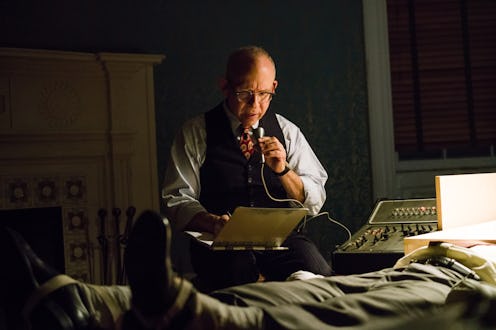Entertainment
Netflix's New Show Details The Creepy True Story Of 1950s CIA Mind Control Experiments

Errol Morris has made a career out of retreading real-life history. His groundbreaking 1988 film, The Thin Blue Line, deeply informed true crime's resurgence, and though it's still his best known work, he's spent the last three decades parsing the idiosyncrasies of human behavior. It's unsurprising, then, that his new Netflix series, Wormwood, is based on a true story. What is remarkable, though, is the show's format, a deft blend of probing testimonies, archived footage, and scripted enactments that push against the boundaries of reality — and then, quite literally, throw its rules out the window.
It's an approach aptly suited to the show's subject, a man whose death has slowly transformed from a dark tragedy to one of America's most highly publicized conspiracy theories. The events leading up to his demise have been so disputed that, like the scenes depicted in Wormwood, it's impossible to know for certain what did or did not happen. The parallel feels deliberate.
Wormwood revisits the case of Frank Olson, a government scientist who plummeted to his death from a New York City hotel room in 1953. According to the Los Angeles Times, the incident was ruled a suicide, but questions remained about whether it was accidental or intentional, and, 20 years later, the mystery deepened. In the mid '70s, stories began to leak about MKUltra, a secret CIA project launched in the early days of the Cold War that, per The New York Times, allegedly included mind control and behavioral experimentation with hallucinogenic drugs. In the wake of these reports, the agency confirmed that Olson had, without his knowledge, been dosed with LSD nine days before his death. According to the NYT, President Gerald R. Ford met with Olson's family to apologize, and the government offered them a financial settlement, which they accepted. Per the Times, a CIA spokesperson "noted that the CIA’s most controversial episodes from the early cold war years, like Mr. Olson’s death, 'have been thoroughly investigated over the years, and the agency cooperated with each of those investigations.'"
Olson's sons eventually came to allege that their father had been murdered to keep him quiet about the CIA operations that were uncovered, and sued the government in 2012, according to The New York Times. In the suit, they alleged their father, who had been working as a bioweapons expert for the Army's special operations division, traveled to Europe in 1953 to visit biological and chemical weapons research facilities. There, the Olsons claimed, he allegedly witnessed extreme interrogations, some resulting in deaths, involving biological agents he had helped develop. They claimed that, upon his return, Olson allegedly seemed to have misgivings about what he had seen, and intelligence officials allegedly began to grow suspicious. A few months later, he attended the meeting in which he was dosed with LSD and later died in an apparent suicide. (Per the 2012 NYT article, the CIA declines to comment on pending court cases, and has not publicly addressed the allegations since).
In 2013, The Frederik News-Post reported the Olson sons' case had been dismissed, in part because of their 1976 settlement with the government, though a federal judge noted that "the public record supports many of [their] allegations ... far-fetched as they may sound.”
Across six episodes, Wormwood dives into the rabbit hole of possibilities still surrounding Olson's death, re-examining all the whys, what-ifs, and maybes that remain six decades later. It's told half in part by Olson's son, Eric, whose spent much of his life on a winding, exasperating search for the truth, and half in part through a hypnotic, dreamlike narrative propelled by Peter Sarsgaard, who plays an afflicted Frank throughout his final days. Like the story that drives it, Wormwood doesn't offer any answers, instead toeing the lines between fact and fiction to tell the fascinating, complicated story.